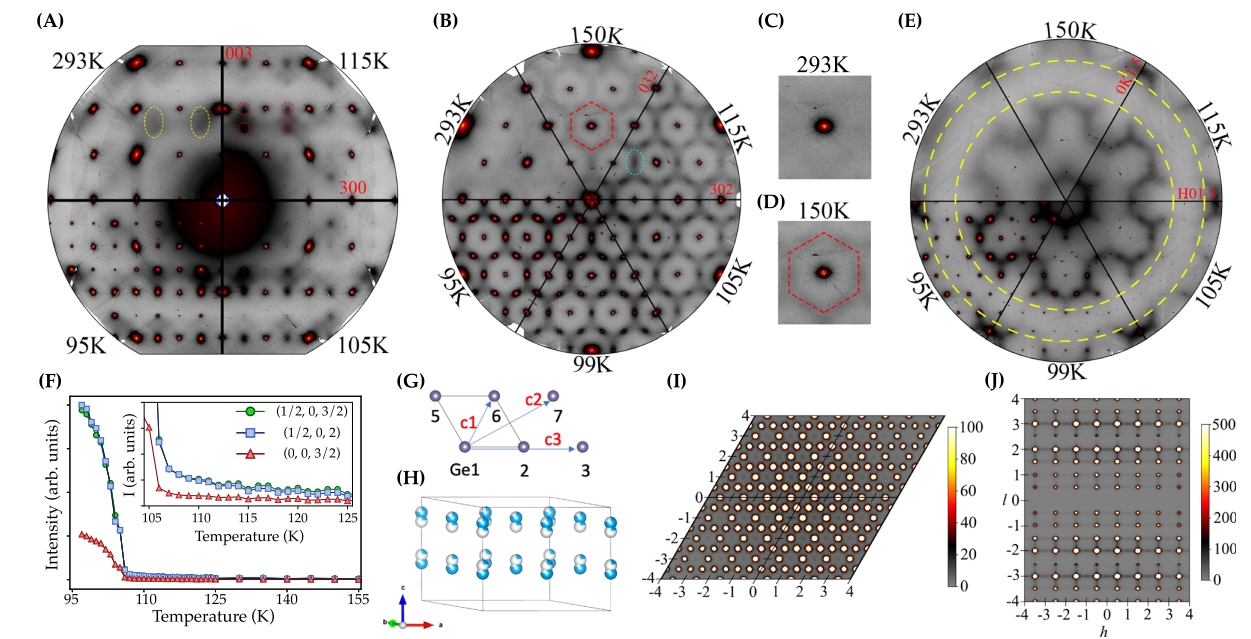Dynamic and unconventional order in magnetic kagome metal FeGe
Imagine a lattice shaped like a network of interconnected triangles, called a kagome lattice, where atoms or particles struggle to find a comfortable arrangement. This unique structure creates a situation known as geometric frustration, where the particles can’t settle into a simple, orderly pattern because of the lattice’s shape. In a magnetic metal called FeGe, scientists have discovered a fascinating result of this frustration: a new type of charge arrangement that behaves in ways reminiscent of liquid crystals, blending the worlds of solid materials and soft matter.
A new research shows 1 how FeGe’s kagome lattice leads to a charge density wave (CDW)—a pattern where electric charges organize in a wave-like fashion. Unlike typical charge patterns in other materials, this one is influenced by frustration, local distortions, and a kind of partial order that makes it stand out.
What Is geometric frustration?
To understand this discovery, let’s explore geometric frustration. In many materials, particles like electrons or magnetic spins (think of tiny magnets) arrange themselves to minimize energy, often aligning in opposite directions to their neighbors, like in an antiferromagnetic material. But in a kagome lattice, the triangular arrangement makes this impossible. Picture three spins at the corners of a triangle, each trying to point opposite to its neighbors. The first two can align oppositely, but the third spin is stuck—it can’t satisfy both neighbors at once. This conflict, or frustration, prevents a simple, stable arrangement and leads to many competing, nearly equal-energy states.
The kagome lattice, made of these triangles, is a playground for studying how this frustration affects not just magnetic properties but also how charges and the lattice itself behave.
A unique charge pattern in FeGe
FeGe is a magnetic metal with layers of iron (Fe) atoms arranged in a kagome pattern, mixed with germanium (Ge) atoms in two roles: some (Ge1) sit within the kagome layers, while others (Ge2) sit between them. At high temperatures (around 400 K, or about 127°C), the iron atoms align in an antiferromagnetic pattern. But the real surprise comes from how the charges behave as the material cools.
As FeGe cools, some Ge1 atoms in the kagome layers pair up, or “dimerize,” and shift slightly out of the plane. This pairing disrupts the lattice’s symmetry and triggers the formation of a charge density wave. However, instead of settling into one fixed pattern, the frustration in the kagome lattice causes a mix of paired and unpaired atoms, creating a dynamic, partially ordered state. This transition happens gradually as the temperature drops, with more atoms pairing up over time, marking a smooth shift to a new kind of order.
Early signs of change

Using X-ray scattering, researchers observed hints of this charge rearrangement even before the full charge density wave forms. At around 125 K (-148°C), well above the transition temperature of 102 K (-171°C), they saw diffuse patterns in their measurements. These patterns suggest that small regions of the lattice start to reorganize locally, but they don’t yet form a consistent pattern across the entire material. The kagome lattice’s frustration ensures that these local changes can’t easily spread without creating defects or stress, resulting in a patchwork of fluctuating charge patterns.
A middle ground of order
Between 125 K and 102 K, FeGe enters a fascinating in-between phase. The charge pattern doesn’t yet repeat perfectly across the material (a property called long-range translational order), but the orientations of the paired atoms stay aligned over large distances. This is called quasi-long-range bond orientational order, and it’s similar to a phase seen in two-dimensional melting, described by a theory called KTHNY (named after its developers). In this theory, melting happens in stages, where defects like dislocations disrupt the perfect alignment of atoms but leave some orientational order intact. In FeGe, the charge pattern behaves similarly, with defects shaping a state that’s neither fully ordered nor completely chaotic.
A charge wave unlike others
In most materials, charge density waves form because of specific electronic or vibrational properties, like a softening of lattice vibrations. But in FeGe, no such softening occurs. Instead, the charge wave seems to arise from the kagome lattice’s frustration, combined with magnetic and electronic interactions. Computer simulations, including Monte Carlo methods and density functional theory, show that the paired-atom configuration is energetically favorable, but the lattice’s geometry prevents a perfect, uniform arrangement. The result is a mixed state driven by local interactions and shaped by the lattice’s constraints.
Why this matters
FeGe’s behavior isn’t unique among kagome metals, but it’s a particularly clear example of how complex patterns can emerge from frustration. This discovery highlights that in frustrated systems, order doesn’t always mean a simple, repeating pattern. Instead, it can take the form of subtle, intermediate states—like aligned orientations or fluctuating regions—that challenge our usual understanding of materials.
This work opens new avenues for studying how order forms in complex systems. By bridging concepts from solid-state physics and soft matter, FeGe shows that even in rigid crystals, order can be dynamic and unconventional, driven by the tension of geometric constraints. For physicists, this is a reminder that the most intriguing discoveries often lie in the balance between order and disorder.
Author: César Tomé López is a science writer and the editor of Mapping Ignorance
Disclaimer: Parts of this article may have been copied verbatim or almost verbatim from the referenced research paper/s.
References
- D. Subires, A. Kar, A. Korshunov, C. A. Fuller, Yi Jiang, H. Hu, D. Călugăru, C. Monagle, C. Yi, S. Roychowdhury, W. Schnelle, C. Shekhar, J. Strempfer, A. Jana, I. Vobornik, J. Dai, M. Tallarida, D. Chernyshov, A. Bosak, C. Felser, B. Andrei Bernevig & S. Blanco-Canosa (2025) Frustrated charge density wave and quasi-long-range bond-orientational order in the magnetic kagome FeGe Nature Communications doi : 10.1038/s41467-025-58725-2 ↩